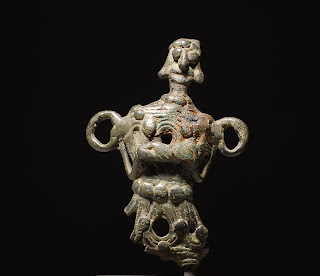 Fig 1 (height 9cm)
Fig 1 (height 9cm)
The horse was central to life in this region, and a great deal of the bronze artwork produced in the first millenium BC related to horse and chariot decoration, used for parades and rituals. Horse bits, cheek pieces, harness rings, bells and standard finials were produced in significant quantities, and quite frequently with a theme of fertility. The image above (Fig 1) is an eighth century BC bronze harness bell, probably from Luristan, depicting a
fertility goddess, with her arms crossed below her breasts holding an object, which is possibly a ritual mace. You may be able to pick out small round objects, at the top of her head, on the lobes of her ears, around her neck, as a belt around her waist, over her shoulders and scattered around her skirt. By their profusion, on a fertility goddess's body, they almost certainly represent a symbol of fertility and probably are some form of fruit, depicting the hoped for abundance of the crop. One fruit that is widely known to be associated with fertility is the pomegranite, and this may be what is represented here. It could also be that this goddess's fertility is expressed by a profusion of nurturing breasts, doubling
up as fruit.
Many much earlier pottery fertility goddesses, from the second millenium BC, have been excavated, particularly in the Elamite capital of Susa. They usually take the form of a naked goddess with arms folded across the chest, or hands clasped beneath the breasts. The later is the case with the image above, although the figure is not naked, and is much more complex than these earlier pottery examples. These simple pottery godesses would have been used in household shrines to protect the family from danger and deprivati
on. Religion in the family ran alongside the official religion, which seems to have been the exclusive realm of priests in Temple communities who served the gods in private. This would have meant little to the largely illiterate population, who would only occasionally be drawn into Temple worship at public festivals as spectators.
The picture of the divine world that developed, directly paralleled that of the king and his extended family. Gods and goddesses were believed to behave in exactly the same way as their royal human counterparts. When represented in art divinities are shown in human form. Gods were particularly involved with controlling the forces of nature, whilst goddesses embodied fertility and maternity.
Returning to bountiful fruit/breasts depicted all over the body of the goddess in Fig 1, a similar circular image, which one is tempted to suggest is the same fruit/breast, occurs, also in profusion, all around the handle of the broad leaf shaped copper dagger below, (Fig 2 and 3). A very similar, but smaller, dagger (23.5cm) in on display in the British Museum which is dated to 2,500-2,000BC, around the time of Naram-Sin's reign. A further very similar example is pictured in a book called "Ancient Iran" by Massoume Price who also placed

The handle of the British Museum example is not so distinct as Fig 2, but it does show, amongst other images, wriggling snakes which link its origins to Elam. See caption f
"The broad leaf shape of this dagger blade closely resembles others excavated in the Royal Cemetery at Ur in Iraq. However the rows of wriggling snakes on the hilt are typical of art from Elam in Iran. This indicates the difficulty archeologists have when trying to decide where and when something was made. Exchange, trade and war booty are all possible reasons for movement of items in antiquity."
Glenn Markoe in his preface to the book "Ancient Bronzes Ceramics and Seals" by Peter Moorey, Emma bunker, Edith Porada and Glenn Markoe, mentions three very common fertility symbols : the palm leaf, the pomegranite and the snake.
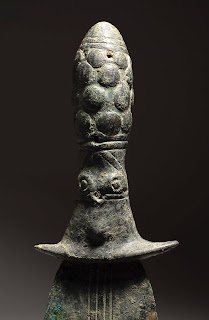
Fig 3
From the close up of the hilt of the dagger, two things stand out. First
ly one can see a rudimentary face, perhaps an expression of a divine presence. Then secondly some cross banding, which may look back to a more primitive form, when the handles of daggers were composite, perhaps when wood or some other material was bound to the blade.
Returning to the snake, it makes an appearance, not only on the hilt of the British Museum's dagger, but also on the ceremonial copper mace below (Fig 4 and 5). Its fertility association presumably is of a phallic nature. An interesting cylindrical seal from
.jpg)
This mace is from the estate F. Casper, restorer at the Chrysler Museum, Norfolk, Virginia, given to him in the 1960's by Walter Chrysler, decommissioned from the Museum at that time, and still bearing its museum reference number. The mace originated in Elam, and of a similar date to the dagger - 2,500-2,000BC. It is decorated with three wriggling snakes, interspersed with ears of corn (Fig 5), obviously another fertility symbol.
.jpg)
In the reign of Shulgi (2094-2047BC), King of Ur, we have clear evidence of Ur's control of Susa, the capital of Elam. During this time an Elamite maritime trader dedicated a macehead to the goddess Ninuruamugub, for the lifetime of Shulgi. This would indicate that the mace had a ritual function during this period of Elam's history. On the macehead, Shulgi's name is
preceded by the divine determinative "dingir", again linking the macehead with religious ritual. This mace is from roughly the same period and probably also served a ritual function in a fertility rite.
A second Elamite mace from a similar period, is pictured below (Fig 6). This mace is very striking in its bold decoration and is from the Axel Guttman collection, exhibited in his museum in Berlin in the 1990's. It seems to depict globular fruit, similar to the hor
se bell shown in Fig 1.

Fig 6 (length 17cms)
Below in FIg 7 is a third mace, this time from Luristan. It is from a later period (1200-1000BC) and is from the Sackler collection. Alternating round the mace are three extremely powerful dominating faces, interpersed with much smaller frightened faces. This seems a representation of the belief of the power of the Luristan King over his enemies. This is a very rare and extremely powerful symbolic piece of art.

Fig 7 (height 7.5cms)
The bronze dagger below (Fig 8) dates from a considerably later period, circa 800BC, a similar date to the fertility goddess in Fig 1, and also from Luristan. The imagery depicted on this dagger is considerably more complex than the fruit/breasts of the copper dagger in Figs 2 and 3 and the mace in Fig 6 , and the ears of corn and the snakes of the ceremonial mace depicted in Figs 4 and 5. It does however show the third fertility symbol mentioned by Glenn Markoe, the palm leaf, more clearly seen in Fig 9, on the hilt to the left of the stand.
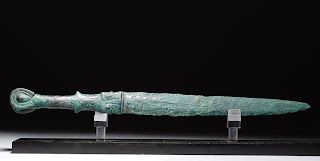
In Fig 9 one can see there is a clear facial mask depicted on the hilt, near the blade, much clearer than on the earlier copper dagger in Figs 2 and 3. When this face is looked at from another perspective, it reveals two horses heads looking outwards as is clear from the side view of the dagger in Fig 10, where one may be able to discern a horses head coming towards the viewer. The facial mask probably represents a divinity, and the horse was central to the economy, and so linked to fertility issues, particularly in more mountainous areas of Luristan where nomadic herding of livestock played an important role. Tastes ha
ve changed with the passage of time, but it seems that the fundamentals of the imagery of religious life remain.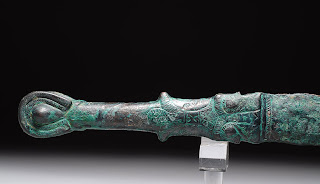


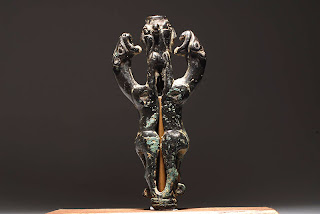
Fig 12 (height 12.5cm)
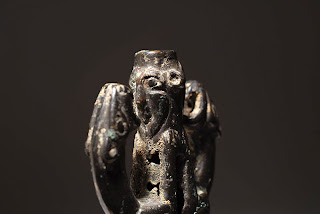
Fig 13
In an article on "The Brozes of Luristan", on Google (The circle of Ancient Iranian Studies), Edith Porada talks about the variety of style and form of these standards. She sees the simplest and most naturalistic examples as belonging to the earliest time of manufacture, perhaps 1200BC, and the more complex an
d abstract the design and decoration, the later the dating, putting such examples to the tenth and ninth century BC. She specifically refers to "the long-necked feline creatures, as depicted in the present example, saying that there does not appear to be any progression from naturalistic to abstract, but rather they appear straight away with l
ong and decoratively curved necks. She also comments that the most carefully formed examples were the earliest, wher
as those less clearly differentiated and formed by more labour saving techniques, belong to a later period. This example is very beautifully formed and intricate, but its design is far from simple. This suggests that it should therefore be dated not too late and not too early, perhaps around 1000BC.
The "standard" has a very distinctive black patina which seems to be produced in bronze with a high tin content.
Below (Fig 14) is a second, even more elaborate standard from Luristan, highly complex and beautifully modelled, again probably dated around 1000BC. It again depicts a Janus divine figure, "Master of the Animals", grabbing by the throat, two strange hybrid creatures, resembling reptiles. Further down the standard, beneath the reptilian images, are two more reptilian heads, and beneath the divine figure are two more Janus figures. The base of the piece is in the form of the legs of gazelles. These standards seem to pimarily represent the desire to control the forces of nature, and thereby symbolically gain power over these forces.

Returning to the Luristan mace depicted in Fig 7, and shown below in Fig 15, the juxtaposition of the powerful conquering face and the frightened vanquished face, reminded me of a number of friezes in Egyptian temples, where the pharoah is painted as very large, and his ememies quite small and frightened, being taken as prisoners in chains. This mace seems to follow a similar symbolic theme. I refer to it here as it maybe represents the King as "Master of the Nations", paralleling the King in the standards as "Master of Nature" (the animals)

Fig 15
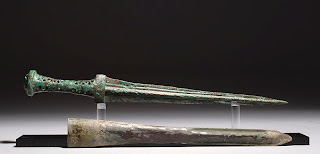
Fig 16 (length 31cm)
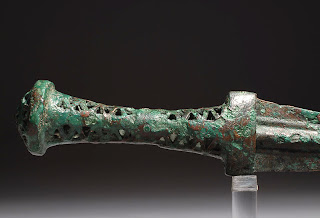
Another common fertility symbol in the Near East is the cow. Fig 18 is an example in ivory, dating to approximately 800BC. It was customery to place such figures in someone's house as a votive offering for worship purposes. The majority of such objects were in bronze or stone, whereas semi precious stones such as lapis lazuli, or gold, or silver or ivory were extremely expensive to own, and were only available to select wealthy individuals, which makes them extremely rare. An ivory piece like this is typical Mesopotamian, and almost certainly made by a craftsman from Northern Syria. Craftsmen from this area were renowned for their skill in carving ivory. and a piece of this quality would almost certainly have been made for export somewhere in the Near east. This piece is very similar to an ivory cow discovered in Nimrud and now in the Metropolitan Museum in New York and is of a very similar size. It is most definitely seen as of Northern Syrian style, and is believed to have been made in Hadatu (present day Aslan Tash), and dated to the eleventh century BC. It is likely that the cow in Fig 18 had the same origin.
There were close connections between the Indus Valley civilization and eastern Iran. One of the prized materials that was traded across the region was lapis lazuli, the blue stone from which this seal is made. The Sar-i Sang mines in the region of Badakhshan in north-east Afghanistan were probably the source for all lapis lazuli used in the ancient Near East.
From here it was carried across Iran, where several lapis working sites have been discovered, and on to Mesopotamia and Egypt.

Fertility rituals have had a large place in religion throughout the Near East. The piece below is from Eygpt, a beautifully crafted faience amulet of the goddess Tawaret, in the guise of a pregnant hippopotamus (Fig 20). She walks upright with drooping breasts and distended belly, wears a striated tripartite wig, and carries the tail of a crocodile down her back and the forelimbs and paws of a lion. These three powerful and feared animals are invoked, in an attempt to harness their power so that the wearer of the charm may become fertile and give birth to a child.

This amulet came from the collection of Mrs M Pearman (died 1999), who was a passionate collector of antiquities and a scholar of hieroglyphs. She lived in Alexandria from 1936-1944, where she acquired this stunning piece.
EYE IDOLS
Below is an Eye Idol made of baked clay (Fig 21) and dating to the later fourth millenium BC (circa 3500-3300 BC), the Uruk period. Eye Idols look remarkably modern, and are simple and abstract. They represent the human form, usually with a flat body and oversized eyes. Four thousand of these figurines were found in a monumental building known as the 'Eye Temple' in Tell Brak, at the site of the ancient city of Nagar in north-eastern Syria. This was officially excavated by Max Mallowan, the second husband of Agatha Christie, who also accompanied him on digs there in 1937-8. More recent excavations have dated the Eye Temple even earlier, with the Oates exploration giving a date of 3900 BC. The site is one of the largest in Mesoptamia, covering an area of some 40 hectares, and rising to a height of 40 metres and one of the ealiest urban centres in Mesopotamia, and indeed the world. The Eye Temple would have been an enormous building, of which only a small portion has been excavated. This building has a massive entranceway with a basalt doorsill and towers on either side, red mud brick walls which are 1.85 meters thick, and even today stand 1.5 meters tall. Radiocarbon dates have placed this structure securely between 4400 and 3900 BC.
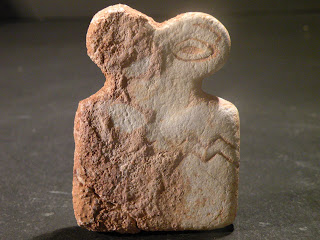
Fig 21 (height 7cm)
The idols themselves vary in size from about 3 to 6 cm in height, and are made of various stone materials (limestone, soapstone and alabaster) or baked clay, and many were incorporated into the mortar of the mud brick walls with which the temple was constructed. The mortar adhering to areas of Fig 15 is clear to see. The interior decoration of the "Eye Temple" was lavish with the altar decorated by a frieze made from colourful stones, silver nails and gold foil, and on the floor and walls were mosaics made from coloured clay cones. Eye imagery and designs are found in the frieze and carvings in the temple, suggesting that the eye was a powerful magical and religious symbol. The large number of Eye Idols found, and their size, suggests that they were left in the temple as votives offerings (gifts to the gods), perhaps representing the people who dedicated them as offerings. This makes the name "eye idol," a misnomer,if the image represents a worshipper. The term "eye idol" probably came from a competing theory, proposed by Mallowan, that they represented the Sumerian fertility goddess Inanna (and thus were idols). Inanna was later identified with the Semitic goddesses Ishtar and Astarte. It could be that the same general image served the purposes of both votive and idol, with worshippers fashioning figurines of themselves patterned after their eye goddess, offering themselves to her. Wide eyes may represent the worshipper's attentiveness to the gods, and vica versa, as has been claimed more generally in Mesopotamian art. Sometimes the "wide eyes" are linked to sexuality and excitement too, and this may provide a connection to fertility. The decoration of the idols varies, and it seems that they may have been personalised. Some have carved lines and zig-zags on their bodies, as the example below (Fig 21), perhaps depicting clothes. Others are examples of group idols, representing more than one figure, some of which have a smaller 'child' figure carved onto the front.
Although Tell Brak is in north-eastern Syria, both the decoration and plan of the Eye Temple resemble that of south Mesopotamian temples, such as those in Uruk and Eridu. Eye symbolism was also popular in Mesopotamia around this time, and eye designs have been found on objects from the Royal Cemetery and temples at Ur. The Eye Idols of Tell Brak, however, are completely unique and have no parallels, in either Syria or Mesopotamia according to the Fitzwilliam Museum.
Below is a second example of an Eye Idol of a very different form (Fig 22). It is a bell shaped marble idol, with drilled-through eyes. This form has been found at a number of sites in northern Mesopotamia, particularly in other parts of Syria, though not at Tell Brak, and is less common than the Tell Brak idols.
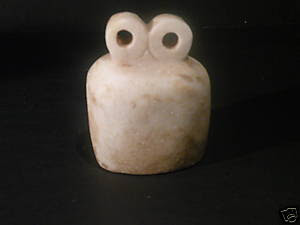
Fig 22 (height 8.5cm)
The lapis lazuli head below (Fig 23) is from the ancient city of Ugarit (now Ras Shamra), to the west of Nagar, where Tell Brak is situated. This head dates to about 1000BC, and like the Eye Idols above, is almost certainly a votive offering of a worshipper, perhaps doubling as a depiction of a god. It is likely that this is a much later form of what, two millennia earlier was depicted in the Eye Idols. One can see from this head, that the eye was very central to the image, and the accentuated brow has similarities to the eye in Fig 21. Also the eyes of this piece would have originally have been made of precious stones which would have made them stand out even more and form a particular focus to the face.
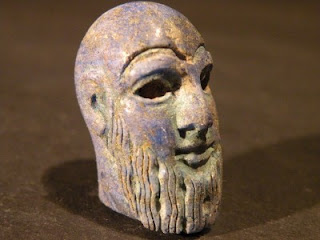
Fig 223(height 3.5cm)
Returning for a moment to the leaf shaped dagger (Fig 2 and 3), and the maces (Fig 4, 5 and 6) from the third millenium BC and described earlier, the fertility symbolism is essentially very simple. The essential ancient images of fertility have continued through the millenia into the later pieces such as the harness bell (Fig 1) and the dagger depicted in Figs 8, 9, and 10 (both from the beginning of the first millenium BC), but the imagery used has grown in sophistication. This same process seems very likely to be also true in the case of the Eye Idols when compared with the lapis head.
If you would like to contact me : malcolm.rushton1@virgin.net
My other blogs are entitled "Shamanism in Ancient Chinese bronzes".
and "Fertility and shamanism in ancient South American cultures".
Some of these pieces, plus many others not photographed here are for sale.